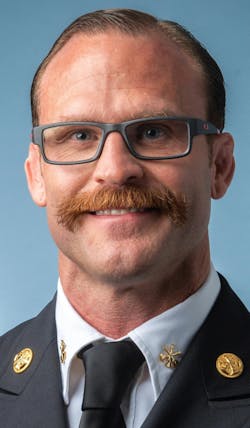Over the past six years in the organization that I love and in which I have served my entire career, more than 80 percent of our leadership team took on a new position. Many of us were thrust into a position in which we are growing and maturing. Some of us were promoted two or three times to different leadership positions, including deputy fire marshal, battalion chief, shift commander, assistant chief and deputy chief. In short, that means that we all are a work in progress and face challenges the best that we can as they come at us.
Thankfully, my organization takes development seriously, so we’ve invested time, money and resources to help us all to grow in the leadership realm. This includes the launch of a recent journey to improve communication, where we hired an outside facilitator, who isn’t from the emergency services world, to make us knowledgeable about how to have crucial conversations that are necessary for organizational and personal growth.
Seven principles
The first step in our effort to improve communication was to read “Crucial Conversations: Tools for Talking When Stakes are High” (McGraw Hill) by Joseph Grenny, Kerry Patterson, Ron McMillan, Al Switzler and Emily Gregory. Once we completed this, we attended in-person training sessions with the same outside facilitator, where we focused on the seven principles of crucial conversations and, specifically, how to identify areas that we can improve. These seven principles consist of: Start with Heart, Learn to Look, Make It Safe, Master Your Stories, State Your Path, Explore Others’ Path and Move to Action.
Start with Heart
When you start a conversation “with heart,” you’re determining the right focus and what you want to get out of the discussion. Don’t make the “fool’s choice,” where you either overreact in the discussion or stay quiet as to not offend anyone. I’ve lived through the fool’s choice, and I know from experience that this will eat you up inside when you intensely care about the work that you do.
The better option is to identify what you want and don’t want from the conversation and to discover how to achieve both objectives.
I still am a work in progress on this one for sure. I care so much about my department, my city, our people and what we experienced the past 17 years since we lost nine firefighters on June 18, 2007, that I get protective and passionate at times. What else can I say? It’s my world.
Learn to Look
Read body language, posture and facial expressions to ensure that those cues are taken into consideration during the conversation. Many times, we can read someone before the conversation even starts by their posture and nonverbal cues.
Make It Safe
Those nonverbal cues allow us to take steps to make the environment safe. I recently had a crucial conversation, and those who had the conversation with me worked hard to make the space safe, so we all could open up and discuss ideas. It was awesome to see that from them and made me proud to see our leaders practicing this. I learned a lot from the conversation and was thankful for their bravery.
Master Your Stories
Stay focused on ideas and remove the emotion the best that you can. When emotion presents itself, work to understand why that person is reacting that way. It goes back to knowing what drives that person and what triggers might set off his/her emotions. My organization provided personality profiles for all of our leadership team, so we can see where our personalities are in relation to our peers. This has been extremely helpful.
State Your Path
Your vulnerability to this point now opens up the pathway to persuasion, so you can identify your path forward. Using the acronym STATE assists in this: Share your facts, Tell your story, Ask others to describe their path to action, Talk tentatively, Encourage listening.
Explore Others’ Path
Be inquisitive about others’ path forward by using the acronym AMPP: Ask (question others, so they open up), Mirror (pay close attention to body language to keep the space safe), Paraphrase (to show that you understand and to validate that you were listening), Prime (use this when you believe that the other person has something more to say, which creates additional safety in the relationship). This enables you to set up the conversation for more safety and to show that you genuinely care in other people’s path forward, not just your own.
Move to Action
The final step is to wrap up the discussion by setting actionable items that include follow-ups, to ensure that the parties are upholding their end on the decisions that were made during the crucial conversation. The hope is that when you walk away from the conversation, both sides have a better understanding of each other. Sometimes, it’s difficult to get to that point, but when you do, you know that the feeling is right, because everyone looks relieved, and safety, hopefully, has been instilled in the relationship going forward.
Be honest with yourself
Crucial conversations are definitely an area that we all must work on. I haven’t seen a leader in my 20 years in this profession who perfected this. Of course, some are better than others. Nevertheless, we all have it in us to master crucial conversations with hard work. After all, it isn’t the other person who makes us emotional. It’s our response to the information that they give us that does.
Take a deep breath and do the best that you can to follow the seven principles of crucial conversations. Again, as I noted above, I still am a work in progress on this. If you’re honest with yourself, so are you. Let’s all be better together.

Dr. David Griffin
Dr. David Griffin is the assistant chief of administration in Charleston, SC. He was the operator of the first-due engine on June 18, 2007, when nine of his fellow firefighters perished. Griffin has come through the ranks in operations in every uniformed position, from firefighter to battalion chief and shift commander to his current position, during his 20-year career in Charleston. He has a bachelor's degree in education from The Citadel, a master's degree in executive fire service leadership, and a doctorate of education in organizational leadership and development. Griffin is the author of "In Honor of The Charleston 9: A Study of Change Following Tragedy," among three other books. He is an international speaker and instructor, a certified Chief Fire Officer and Chief Training Officer with The Center for Public Safety Excellence, an IFSAC/Pro Board-certified Fire Officer IV and a graduate of the Executive Fire Officer Program from the National Fire Academy. He is a graduate of Harvard University's Kennedy School of Executive Education program: Senior Executives in State and Local Government and of the Psychology of Leadership program at Cornell University's SC Johnson College of Business. Griffin is the owner of On A Mission, LLC, at drdavidgriffin.com.






